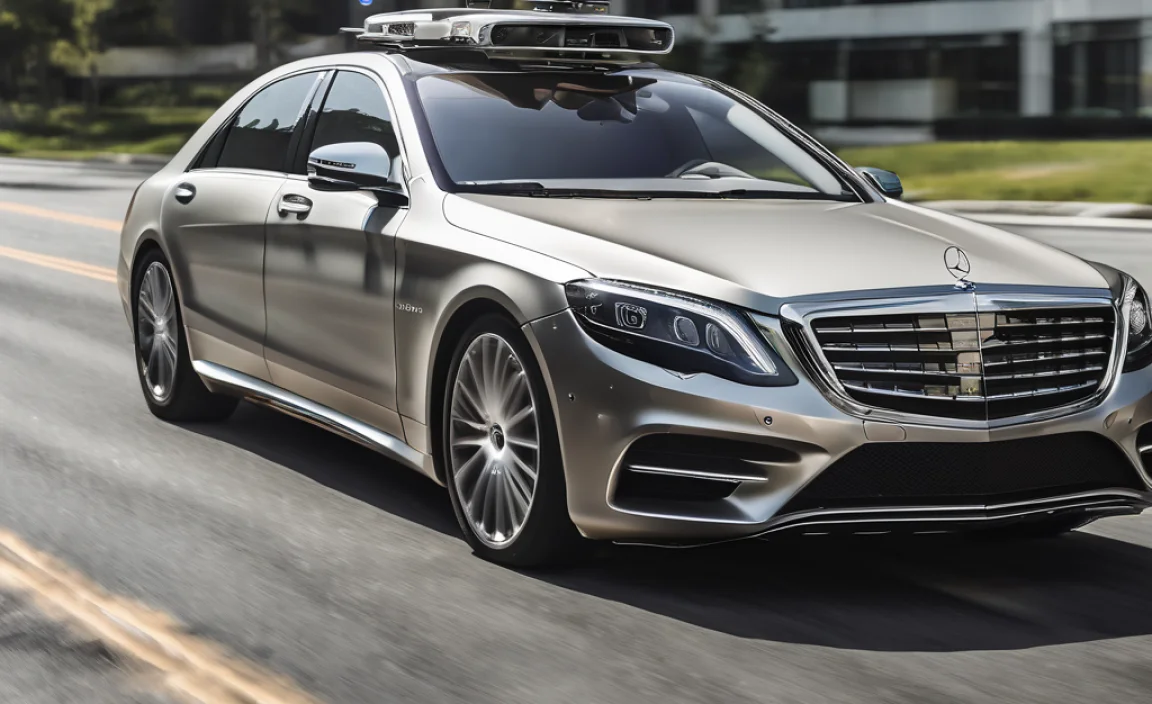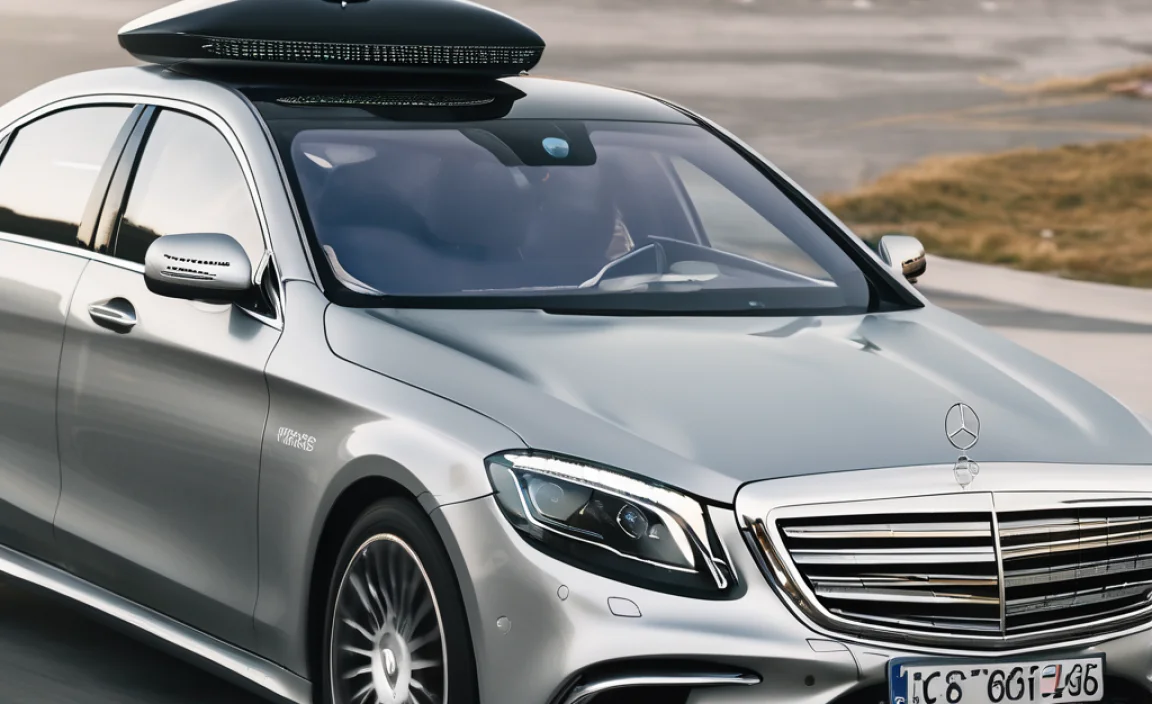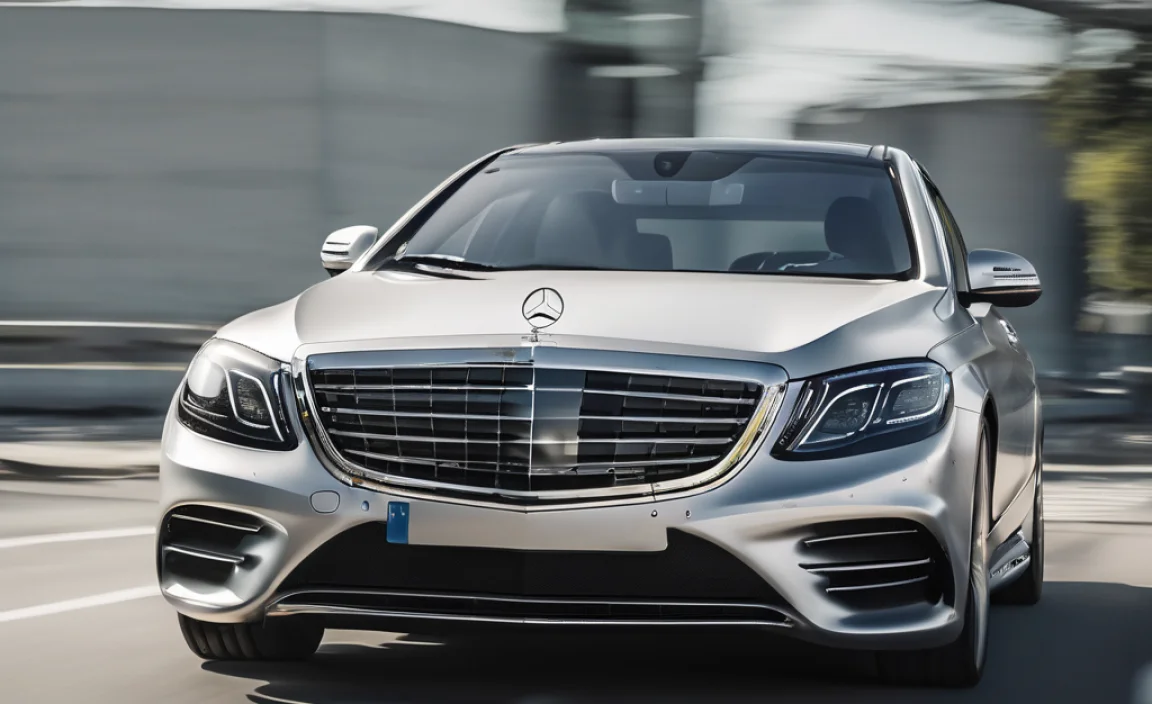A Mercedes S-Class crash involving self-driving features highlights critical safety lessons for all drivers. Understanding these insights can enhance your awareness and safer driving habits, even when not using advanced driver-assistance systems. Focus on responsible technology use and continuous learning to stay safe on the road.
We’ve all seen or heard about advanced cars with remarkable technology. When a vehicle like the Mercedes-Benz S-Class, known for its luxury and innovation, is involved in a crash, especially when its self-driving capabilities are part of the story, it naturally sparks a lot of questions and concerns. It’s easy to feel a bit uncertain about these sophisticated systems. But don’t worry! This isn’t about pointing fingers or creating alarm. Instead, we’re going to break down what happened and, more importantly, what we can all learn from it. Our goal is to give you practical, easy-to-understand insights that will boost your confidence and make you a safer driver, regardless of whether your car has advanced driver assistance or if you’re just starting your driving journey.
Frequently Asked Questions
What exactly happened in the reported Mercedes S-Class crash?
Reports of crashes involving self-driving or advanced driver-assistance systems (ADAS) often stem from situations where the technology’s limitations were reached, or it was used outside its intended operating conditions. For example, a crash might occur if the system was engaged on roads it wasn’t designed for, or if external factors like poor weather obscured sensors.
Is Mercedes-Benz’s self-driving technology unsafe?
Mercedes-Benz vehicles, including the S-Class, are equipped with highly advanced driver-assistance and, in some limited forms, automated driving systems. These systems are rigorously tested and designed to enhance safety and comfort. However, no system is infallible. It’s crucial to understand that these are assistance systems, and the driver remains responsible for monitoring the vehicle and the driving environment at all times.
What is the difference between driver assistance and self-driving?
Driver assistance systems (like adaptive cruise control or lane keeping assist) help the driver but require constant supervision. True self-driving (or autonomous driving) aims for a vehicle to handle all driving tasks under specific conditions without human intervention. Mercedes-Benz currently offers advanced driver assistance and conditionally automated driving, meaning the driver must be ready to take over at any moment.
What role does the driver play when using advanced features?
The driver’s role is absolutely critical. Even with the most advanced systems, the driver must remain attentive, ready to intervene, and understand the system’s limitations. Think of it as having a very capable co-pilot, but you’re still the captain of the ship and must be ready to steer.
How can I learn about my car’s specific safety features?
The best way is to consult your owner’s manual. It provides detailed information about each system, its capabilities, and limitations. Many manufacturers also offer online resources or videos explaining their technologies.
Are these systems more dangerous than human drivers?
Statistically, human error is still the leading cause of most road accidents. ADAS are designed to reduce certain types of human errors, like fatigue or distraction. However, the novelty of these systems and the potential for misunderstanding their capabilities can introduce new risks. Responsible usage and driver awareness are key.
Where can I find official safety information about Mercedes-Benz systems?
Refer to the official Mercedes-Benz website for product details and safety information. Reputable automotive safety organizations like the National Highway Traffic Safety Administration (NHTSA) also provide valuable resources on vehicle safety technologies and crash test data.
Essential Safety Insights for Every Mercedes Owner
The automotive world is buzzing with innovation, and Mercedes-Benz leads the charge with its cutting-edge technology. The S-Class, in particular, is a marvel of engineering, often showcasing systems that hint at the future of driving. When news of a crash involving an S-Class, especially one where its advanced driving systems may have been a factor, surfaces, it’s a moment for us all to pause and learn. These events, while unfortunate, offer invaluable lessons about how we interact with modern vehicle technologies. It’s not about being scared of the tech; it’s about understanding it better to drive smarter and safer.
As a Mercedes-Benz enthusiast and someone who loves making car tech understandable, I want to demystify these situations. We’ll dive into what these advanced features are, what they can and can’t do, and most importantly, how they impact your role as the driver. By the end, you’ll feel more confident about your car’s capabilities and how to use them responsibly, ensuring every drive is as safe as possible.
Understanding Mercedes-Benz’s Advanced Driver-Assistance Systems (ADAS)

Mercedes-Benz vehicles are equipped with a suite of advanced driver-assistance systems (ADAS). While often colloquially referred to as “self-driving,” it’s crucial to understand that most of these systems are designed to assist the driver, not replace them. The goal is to enhance safety, reduce driver fatigue, and improve comfort. For models like the S-Class, these systems are particularly sophisticated.
Key systems often found include:
- DRIVE PILOT: This is Mercedes-Benz’s most advanced conditionally automated driving system. It allows for driving in certain situations, like heavy traffic on highways, where the system can take over steering and speed control under specific conditions. However, the driver must remain attentive and ready to take back control.
- Active Distance Assist DISTRONIC: This system helps maintain a set speed and a safe distance from the vehicle in front. It can also brake for you.
- Active Steering Assist: This system helps the driver stay in their lane by providing active steering intervention.
- Active Brake Assist: This system can detect other vehicles, pedestrians, and cyclists and can brake automatically if a collision is imminent.
- Traffic Sign Assist: This system recognizes speed limits and other traffic signs and displays them to the driver.
It’s vital to remember that ADAS rely on sensors, cameras, and radar. These components can be affected by weather conditions (heavy rain, snow, fog), poor lighting, or if they are dirty or obstructed. This is where driver vigilance becomes paramount.
Analyzing the “Self-Driving” S-Class Crash Scenario

When a headline reads “Self-driving Mercedes S-Class Crash,” it often simplifies a complex situation. Real-world incidents involving advanced vehicle technology rarely stem from a single cause. Instead, they are typically a confluence of factors:
1. Technology Limitations and Operating Conditions
Every ADAS has defined operational design domains (ODDs). These are the specific conditions under which the system is designed to function safely. For example, DRIVE PILOT might be intended for use only on certain types of highways, in clear weather, and within specific speed ranges. If the system is used outside these conditions—perhaps on a rural road, in heavy fog, or when the lane markings are unclear—its ability to operate safely is compromised. The crash might occur when the system encounters a situation it wasn’t programmed to handle.
2. Driver Awareness and Intervention
The most critical element in any ADAS-equipped vehicle is the driver. Systems like DRIVE PILOT require the driver to be attentive and ready to take over control instantly. Becoming overly reliant on the technology (sometimes called “automation complacency”) can lead to reduced situational awareness. If a driver is distracted or assumes the car will handle everything, they might not be prepared to react when the system signals a need for human intervention or when an unexpected hazard appears.
3. Environmental Factors
Sensors are the “eyes” of these systems. Heavy rain, snow, fog, direct sunlight glare, or even a dirty windshield can impair the sensors’ ability to accurately perceive the environment. If the sensors can’t “see” an object or lane marking clearly, the ADAS might not react appropriately, potentially leading to an accident. Likewise, construction zones with erratic lane closures or unusual road layouts can confuse these systems.
4. Interaction with Other Road Users
Other drivers’ actions can also play a role. A sudden lane change by another vehicle, unexpected braking, or even erratic behavior from pedestrians can present challenges for ADAS. The system might not be able to predict or react as quickly as an experienced human driver in certain unpredictable scenarios.
Key Takeaways for S-Class Owners and Beyond
Whether you own an S-Class with the latest DRIVE PILOT or a C-Class with advanced cruise control, these insights are universally applicable. The principles of safe operation and driver responsibility remain the same.
1. Know Your System Inside and Out
Your owner’s manual is your best friend. Take the time to thoroughly read and understand the capabilities and limitations of every driver-assistance feature in your Mercedes-Benz. Pay close attention to sections detailing when and where each system can be safely used. You can often find digital versions on the Mercedes-Benz USA owner’s portal.
2. Stay Attentive – You Are the Driver
This cannot be stressed enough. Even when a system is active, your primary responsibility is to drive. Keep your hands on the wheel (or at least within reach), your eyes on the road, and your mind engaged with the driving task. Never use ADAS as an excuse to become distracted by your phone, engage in complex conversations, or take your focus off the road.
3. Respect Operational Design Domains (ODDs)
Do not push the system beyond its intended limits. If DRIVE PILOT is designed for highway use in good weather, don’t try to use it on winding country roads or during a blizzard. Understand the specific ODD for each feature in your car.
4. Keep Sensors Clean and Unobstructed
Regularly clean your car’s exterior, paying special attention to the areas where sensors, cameras, and radar units are located. A simple wipe-down can ensure the systems have a clear view of the road. Check your manual for the precise locations of these components.
5. Practice and Gradual Familiarization
When trying out new ADAS features, do so in a safe, controlled environment, like an empty parking lot or a quiet road with light traffic. Gradually increase your experience with the system as you become more comfortable with its responses.
6. Pay Attention to System Warnings
Your Mercedes-Benz will provide visual and audible alerts to inform you about the status of ADAS features, including when it needs you to take over control. Always respond immediately to these prompts.
7. Continuous Education
The technology in cars is constantly evolving. Stay informed about updates and advancements in automotive safety by following reputable sources. Understanding how these systems work helps you use them more effectively and safely.
Mercedes S-Class Safety Features vs. Fully Autonomous Driving

It’s a common misconception to equate Mercedes-Benz’s advanced systems with full Level 5 autonomy (where the car can drive itself anywhere, anytime, without human intervention). Current production vehicles, including the S-Class, primarily offer Level 2 (Advanced Driver Assistance) or, in very specific limited circumstances, Level 3 (Conditional Automated Driving) capabilities.
Let’s break this down:
| SAE Level | Description | Driver’s Role | Mercedes-Benz Example |
|---|---|---|---|
| Level 0 | No Automation | Full control, no driver assistance. | Basic braking and steering systems. |
| Level 1 | Driver Assistance | Assists with either steering OR acceleration/braking. Driver handles the rest. | Adaptive Cruise Control (ACC) OR Lane Keeping Assist. |
| Level 2 | Partial Automation | Assists with BOTH steering AND acceleration/braking simultaneously. Driver MUST supervise and be ready to intervene. | Active Distance Assist DISTRONIC with Active Steering Assist (often bundled). |
| Level 3 | Conditional Automation | System can handle all driving tasks under specific (limited) conditions, and the driver can engage in other activities, BUT must be ready to take over when prompted. | DRIVE PILOT (in limited geographical areas and conditions, e.g., traffic jams on specific highways). |
| Level 4 | High Automation | System can handle all driving tasks and monitor the driving environment within its ODD. Driver intervention not required within ODD. | Not yet in production consumer vehicles. (e.g., Waymo robotaxis in specific service areas) |
| Level 5 | Full Automation | System can handle all driving tasks in all conditions. No human driver needed. | Fictional/future concept. |
As you can see from the table above, even the most advanced systems currently available in a Mercedes-Benz S-Class fall into Level 2 or Level 3. This means that the driver’s role is always active and crucial.
Preparing for the Future of Driving Safely

The conversations around crashes involving advanced vehicles are essential for progress. They remind us that technology is a tool, and like any tool, it must be used correctly and with a full understanding of its capabilities.
For us owners, this means embracing the incredible benefits of ADAS while maintaining a healthy respect for their limitations. It’s about becoming a more informed and responsible driver, leveraging technology to enhance safety without ever relinquishing ultimate control and awareness.
Think about the technologies available today, such as those offered by Mercedes-Benz. They are designed to make your driving experience safer and more comfortable. For instance, features like Active Steering Assist (part of Level 2 systems) can help reduce the mental load on long drives by keeping you centered in your lane. Similarly, Active Brake Assist is designed to prevent or mitigate collisions, a critical function in daily commutes. To ensure these and other systems function optimally, proper maintenance is key. This includes ensuring all sensors are clean and functioning, which you can easily do yourself by following guidelines in your owner’s manual. For more complex checks, always consult your local authorized Mercedes-Benz service center.
Furthermore, staying updated on automotive safety research is beneficial. Organizations like the Insurance Institute for Highway Safety (IIHS) conduct rigorous testing and provide valuable insights into vehicle safety technologies. Understanding their findings can further empower you as a driver.
As we look towards a future with potentially more autonomous vehicles, the lessons learned today will be even more critical. The focus will shift to how humans and machines will collaborate safely on the road. For now, being an educated, attentive, and responsible driver is the most advanced safety feature you can implement.
By understanding your Mercedes-Benz’s systems, respecting their boundaries, and always prioritizing your own vigilance, you can confidently enjoy the advanced technology your car offers, knowing you’re driving as safely as possible. Happy, safe driving!